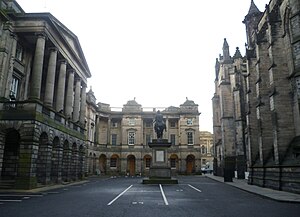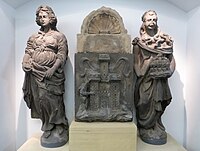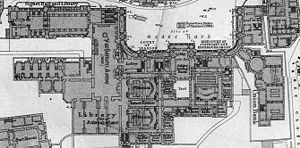Parliament House

Parliament House in Edinburgh, Midlothian, is the seat of the Court of Session and of the High Court of Justiciary. Before the Union of Scotland and England, the Parliament of Scotland sat there, hence its name.
Parliamnet House stands in the Old Town, just off the Royal Mile, beside the High Kirk of Edinburgh.
Parliament Hall
The oldest part of Parliament House is Parliament Hall, which the Town Council of Edinburgh, at its expense, had built as a permanent home for the parliament, and as such is the oldest extant purpose built parliamentary building in the British Isles.[1] It was completed in 1639 to the design of James Murray.[2] It has a dramatic hammerbeam roof made of Scandinavian oak, which may have been designed to evoke Parliament Hall at Stirling Castle, a previous home to the Scottish court.
After the Act of Union 1707 the Parliament of Scotland ceased, and the building lost the function for which it was built. The Hall was used for the sitting of courts, but in recent times has been subject to restoration work and now remains open as a meeting place for lawyers.
Beneath Parliament Hall lies the Laigh Hall, of similar plan form but considerably less height. In the mid 18th century this held a coffee house run by Peter Williamson (Indian Peter).
Artwork in Parliament Hall

The right-hand example of the two smaller fireplaces has carved scenes from The Merchant of Venice.
Statues on the north wall include naval heroes: Henry Dundas, 1st Viscount Melville by Sir Francis Chantrey (1818); Robert Dundas, 2nd Viscount Melville by Sir Francis Chantrey (1824); Lord Cockburn by William Brodie (1863).
On the east wall: Duncan Forbes by Roubiliac (1752); Lord Jeffrey by Sir John Steell (1855); Lord President Boyle by Sir John Steell (1860); Lord President Blair by Sir Francis Chantrey (1815).
On the west wall: Sir Walter Scott by John Greenshields (1835); Henry Erskine by Peter Turnerelli (1811); and various busts by William Brodie and Sir John Steell.
In a corridor beyond the south door of the hall stand figures of "Justice" and "Mercy" by Alexander Mylne (1637) which formerly stood over the main entrance on Parliament Square.
Courts

Even while the old Parliament was still in existence, parts of the buildings were used for legal cases, and afterwards this became the main function of the building. The building is now used to house the College of Justice and other connected functions. In modern times, the building is chiefly used by the Court of Session, which hears civil cases. Most of the work of the High Court of Justiciary, which hears criminal cases, takes place in a dedicated building on the other side of the Royal Mile which formerly housed Edinburgh's Sheriff Court.
Libraries
The Advocates' Library was founded in 1682, and is currently located in a William Henry Playfair-designed building to the west of the south end of Parliament Hall. It remains a heavily-used legal resource. As well as collecting legal works, it was also a deposit library, and in 1925 the non-legal books in their collection were gifted to the new National Library of Scotland, which is located next to the library, on George IV Bridge.
To the west of the north end of Parliament Hall is The Signet Library. It is a private library, funded by members of The Society of Writers to Her Majesty's Signet, who are generally practising solicitors. Construction began in 1810 to a design by Robert Reid, and it presents a classical front to Parliament Square. This façade wraps around Parliament House as well, and replaced the existing Scottish baronial façade.
References
- Location map: 55.94917 -3.19056